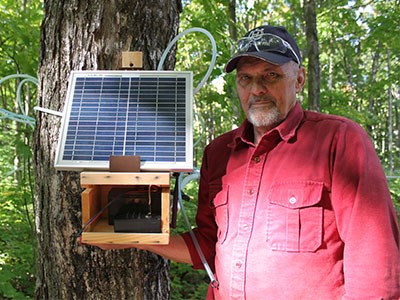With 100 acres of maple trees to survey, it would often take John Cambridge an entire day walking the sugar bush to pinpoint a source of lost pressure in the tap lines at Thompson’s Maple Products, and even then, his success at diagnosing the cause of the problem — amongst 20,000 taps — could be dubious.
Enter Tap Track, a digital monitoring system that alerts producers when a loss of vacuum occurs and identifies its location with greater accuracy than the traditional walk in the bush.
“The idea of this system is to put sensors all through the bush that will monitor the amount of vacuum you have, so that when something goes wrong, you can go out and fix it,” said Cambridge, a seasonal worker at the sugar bush.
Located on St. Joseph Island, about a 45-minute drive southeast of Sault Ste. Marie, the sugar bush has been in the Thompson family since 1977. Current operators Doug and Joyce Thompson produce an average of 20,000 litres a year of maple syrup, in addition to maple sugar and other products, which is exported to the Far East, China, Chile, Argentina, Europe, and the U.S. and across Canada. Theirs is one of the largest maple syrup operations in Ontario.
So when a tap goes down because of severe weather, like this past fall when more than 200 trees were felled by high winds, it impacts production. The sooner the taps can get back up and running, the better for business.
For Tap Track to work, sensors are placed along the main lines of the sugar bush, which are connected to transmission boxes mounted on trees throughout the acreage. Those sensors can trace when vacuum on a line — used to transfer tree sap to storage vats for processing — has been reduced and wirelessly transmit that information to a computer system.
The transmission boxes are powered by 12-volt batteries charged by solar panels, and producers can set how often transmission occurs.
Back in the office, a map of the entire sugar bush pops up on a laptop screen, with multi-coloured dots indicating the lines’ status like traffic lights: green means everything is operational, yellow indicates there’s an issue, and red is a warning signal for a potentially more significant problem.
As the system’s main operator, Cambridge no longer has to guess at where a problem occurs, creating more efficiency and reducing down time, saving the company time and money.
“You get to the point where, just by looking at the computer screen you can almost tell what’s wrong by the amount of vacuum you’re losing,” Cambridge said.
The idea for Tap Track was launched by Doug Thompson’s desire for a more efficient system, and he found the help he needed right in his hometown.
“He came in one day looking for someone who could help him to come up with a monitoring system for his industry, and that’s basically how it started,” said Mark Lutes, owner at Algoma Business Computers. “We started developing it for Doug initially and it worked so well that Tap Track was born after that.”
Lutes and his programmer, Trevor Bryant, devised the system from scratch and within the first year, Thompson realized a 10 per cent increase in sap collection — the system paid for itself. He was so pleased, a producer colleague in Vermont tried it; he, too, realized immediate efficiencies.
“It pays for itself so quickly and it works,” Lutes said.
Thompson, Lutes and Bryant, who are now partners in the venture, decided Tap Track had commercial value and successfully approached the Sault Ste. Marie Innovation Centre for some startup funds.
Each Tap Track system comes with a laptop and the software, producers purchase the number of sensors they need, and the system is then tailored to their specific needs.
“Every bush is different and every layout is different,” Lutes said. “What we initially need from them is a layout of the land, so we can create a map of where their main lines are, and once we have the map of their land, we can build a system around what their requirements are.”
Now approaching its fourth year, Tap Track has been introduced to markets in Canada and the U.S., primarily in the New Hampshire and Vermont areas, where that first client is such a believer in the system, he’s become a distributor.
Their work has piqued interest elsewhere: Tap Track earned the 2013 Premier’s Award for Agri-Food Innovation Excellence, and this year was nominated for a prestigious Manning Innovation Award.
Ultimately, the partners want to “tap” into the predominant market for maple syrup production: Quebec.
“We’re still not sure how to do that properly. We’re concentrating on what we can do now,” Lutes said. “As it gets more popular, I think, we’ll get more interest from some of the distributors that market into Quebec.”
They’re also working on additions to the system, such as a tank sensor that could help monitor the level of sap present during the boiling process to avoid overflow.
Cambridge is grateful for the system — both for saving him bone-chilling walks through the snow in early spring, and for the increase in productivity.
“It makes the whole operation that much more efficient, because if that whole (screen) is green, then I can go and do something else,” he said. “I can go put syrup in bottles, or whatever needs to be done.”




